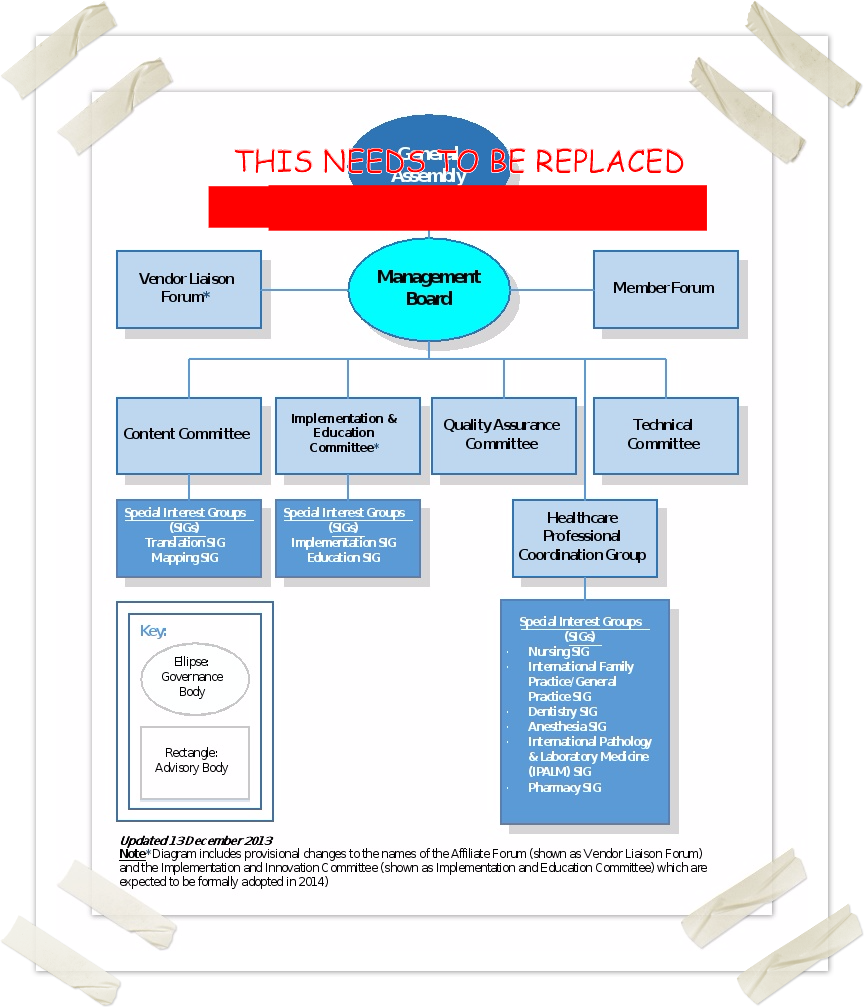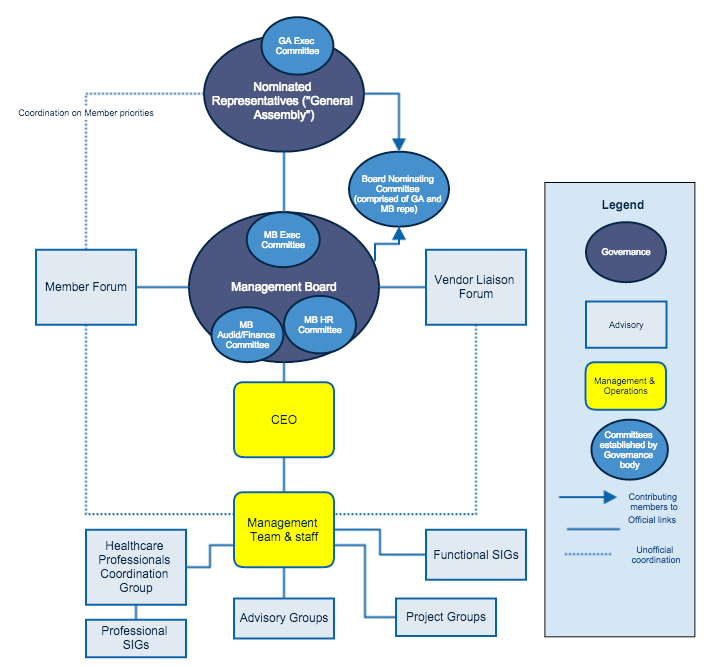Page History
...
- The International Health Terminology Standards Development Organisation (IHTSDO)
- Members of IHTSDO and National Release Centers
- IHTSDO Standing Committees and Working Groups
- National Release Centers
...
- IHTSDO Collaborative Space
Why is this important?
IHTSDO is the international not-for-profit Organisation that owns and administers SNOMED CT, and owns the rights to SNOMED CT and related terminology standards.
...
IHTSDO is an association governed by a General Assembly that contains one representative of each of its national Members.
IHTSDO seeks to improve the health of humankind by fostering the development and use of suitable standardized clinical terminologies, notably SNOMED CT, in order to support safe, accurate, and effective exchange of clinical and related health information. The focus is on enabling the implementation of semantically accurate health records that are interoperable.
The purpose of IHTSDO is to develop, maintain, promote and enable the uptake and correct use of its terminology products in health systems, services and products around the world, and undertake any or all activities incidental and conducive to achieving the purpose of the Association for the benefits of the members.
The bodies and forums of IHTSDO are the foundation for the continuous maintenance, development and distribution of SNOMED CT, and they provide the organizational framework for communication and collaboration between the different parts of the SNOMED CT community.
Members of IHTSDO
IHTSDO now has more than 25 national Members. An updated list of the current members can be found at the IHTSDO web page (http://snomed.org/members/). Members of the IHTSDO can be either an agency of a national government or another body endorsed by an appropriate national government authority within the country it represents. The IHTSDO welcomes new Members.
The IHTSDO Members pay a fee, based on national wealth, to the IHTSDO which gives them the right to a seat on the General Assembly. IHTSDO does not charge Affiliate Licensees for use of the SNOMED CT International Edition within Member countries. Licensing is also free in the poorest countries and for certain approved public-good uses in other countries. In other cases, low-cost per-institution charges apply to the use of SNOMED CT in operational systems involved in data creation and/or analysis. All use of SNOMED CT is subject to the acceptance of the terms of the SNOMED CT Affiliate License agreement (http://snomed.org/license.pdf) and the terms of sublicenses issued to end-user organizations by Affiliate Licensees. Members may also impose additional conditions on use of SNOMED CT within their countries. For example, a Member may require licensees to support and include its National Extension in its implementations.
National release centers
IHTSDO Members undertake a range of activities related to their involvement in the IHTSDO and their role in distributing, extending and supporting the use of SNOMED CT in their country. The Organisation or agency that coordinates this role in each country is referred to as a National Release Centre (NRC). National Release Centers provide a single point of contact for communications with IHTSDO and other IHTSDO Members. Within their own countries, NRCs manage the use of SNOMED CT and communicate with a range of stakeholders, including SNOMED CT Affiliate Licensees, healthcare institutions, clinical groups and end users.
Governance
An overview of IHTSDO's governance
...
and advisory structures are shown in the following figure.
| Anchor | ||||
|---|---|---|---|---|
|
| Anchor | ||||
|---|---|---|---|---|
|
| Page break |
|---|
General Assembly
The General Assembly is the highest authority in IHTSDO and contains one representative from each of its national Members. The General Assembly is collectively responsible with assuring that the Purpose, Objects and Principles of the Association are pursued and that the interests of IHTSDO are safeguarded. It can make binding decisions regarding all matters relating to IHTSDO, subject to and in accordance with the provisions of the Articles of Association, such as budget, work plan and strategic goals. It is recommended though not required that General Assembly representatives attend all meetings. Face to face meetings occur usually twice per year with occasional teleconferences and electronic voting.
| Anchor | ||||
|---|---|---|---|---|
|
The Management Board is appointed by the General Assembly. Members have the opportunity to nominate delegates to the Board. The Management Board The highest governance body of the IHTSDO is the General Assembly which includes a formally appointed representative of each IHTSDO Member. The General Assembly appoints a Management Board which directs the Association and has the responsibility for key business decisions. It has at least three face-to-face meetings per year with teleconferences between these meetings.
The Management Board also appoints the Chief Executive Officer (CEO) is appointed by the Management Board and , who has day-to-day responsibility for running the conduct of the business. The CEO is supported by a team of senior staff responsible for particular lines of business.
IHTSDO advisory bodies
Standing Committees
The IHTSDO has four Standing Committees which provide advice to the Management Board. Committee members are elected by the General Assembly. They meet face to face twice a year, and between those meetings have regular conference calls. Meetings of these committees are generally open to observers.
Content Committee: Is responsible for providing advice on issues related to the definition and maintenance of the clinical content and structure of SNOMED CT and its related standards.
Implementation and Education Committee: Is responsible for providing advice, assistance and education to enable effective practical implementation of SNOMED CT in ways that aid the management of clinical information and assist clinical decision making.
Quality Assurance Committee: Is responsible for the development and quality assurance of SNOMED CT and its related standards and the Association's other Terminology Products in harmony with proper respect to external standards.
Technical Committee: Is responsible for focusing on technology related issues relating to the use and application of SNOMED CT, the fitness for purpose of frameworks and tools adopted in the application of SNOMED CT.
Working Groups
Working groups include
- Special Interest Groups (SIGs) which are open forums that examine issues on particular topics or healthcare specialty areas; and
- Project Groups which have defined time-limited objectives.
There are two distinct types of Special Interest Group
- Topic Based SIGs cover a general topic area (e.g. implementation, translation) and report to one of the Standing Committees; and
- Professional Specialty SIGs focus on requirements of a particular clinical discipline or specialty (e.g. Nursing, Anesthesia). These SIGs report to the Healthcare Professional Coordination Group which includes the chairs of each of the professional SIGs.
organization. A Management Team, with members each responsible for a particular line of business, supports the CEO and directs the work or additional employees.
Advisory bodies
| Anchor | ||||
|---|---|---|---|---|
|
Member Forum
Each IHTSDO Member is entitled to choose a representative to the IHTSDO Member Forum (MF). The MF acts as an advisory body to the Management Board.
The MF is also a means for optimizing the collaboration and coordination among IHTSDO Member countries provides a means for Members to have discussions on specific Member issues. Moreover, the MF facilitates contact and communication between countries with similar foundations, needs, priorities, etc. It is recommended that each Member gets involved with and makes use of the MF.
The MF can raise issues of concern to the Management Board and is asked by the Management Board for specific feedback on items. The MF is the conduit for communicating widely on consultations that IHTSDO may undertake. These consultations may include specific issues related to SNOMED CT content or IHTSDO documents, products and services. The MF is also a key player in determining which IHTSDO work items should be undertaken and prioritized.
Vendor Forum
The structure and role of the Vendor Forum (VF) is currently being revised as part IHTSDO's vendor strategy. As an expert group from a range of industry sectors, the VF will identify ways to facilitate use of SNOMED CT.
| Anchor | ||||
|---|---|---|---|---|
|
The role of each Advisory Group is to provide advice to the applicable Management Team member(s) on specific areas that are included in the Terms of Reference to further the knowledge and direction of the organization. At the beginning of each year, each Advisory Group develops a group work plan outline, determines whether Task and Finish sub-groups are required, outlines any resource requirements needed, and lays out a set of measures in order to monitor the progress of the applicable group work plan.
Advisory Group members are selected by two different nomination processes. The Terms of Reference of each Advisory Group describes which of the two is relevant (or if a combination of the two is used).
- Member-based nominations are used when IHTSDO seeks to create a forum for IHTSDO staff to work closely with IHTSDO Members. Under this system, Members nominate representatives to serve on an Advisory Group, so the Advisory Group members are representing their Member countries.
- Standard nominations rely on a standard, open, skills-based nomination process. Advisory Group members selected through this process may submit to IHTSDO any approved travel expenses for reimbursement to attend approved face-to-face Advisory Group events (the IHTSDO Travel Policy has more information about approved expenses and means of submission).
| Anchor | ||||
|---|---|---|---|---|
|
Besides the Standing Committees, a set of Special Interest Groups (SIGs) function as advisory bodies on issues related to their specific areas relevant to the strategic direction and resulting specific work areas of IHTSDO, its Members and the Community of Practice.
The SIGs are open to anyone who is interested, and they are important for IHTSDO to ensure professional and pertinent input to the Management Board and the Standing Committees. Therefore it is also important that the NRCs encourage appropriate national Affiliates/users to engage in these groups, in order to support a broadly-based composition of the groups with high professional competency and experience.
Two types of Special Interest Groups exist:
- The Functional SIGs provide expert advice and feedback on core functional areas (e.g. education, translation, implementation, etc.) within the scope of IHTSDO work, from an international perspective. The functional SIGs report to one of the Standing Committees.
- The Professional SIGs provide advice to IHTSDO on relevant clinical aspects and a link to appropriate international clinical professional groups (e.g. nursing, pathology, etc.).
Further information about the SIGs and instructions for how to join can be found on the IHTSDO webpage: To join a Special Interest Group or to access information about one of the other groups you need to create an account on the IHTSDO Collaborative Space (see http://snomed.org/collabnet).
National release centers
sig.
| Anchor | ||||
|---|---|---|---|---|
|
| Anchor | ||||
|---|---|---|---|---|
|
Confluence is an online forum/space where the people within IHTSDO Governance and Advisory Bodies can communicate and share information. Confluence facilitates a range of types of communications, including written discussions, meeting announcements and document sharing.
IHTSDO Members, Affiliates, or other interested parties can gain access to the Collaborative Space to learn more about IHTSDO, SNOMED CT, or to participate in a Special Interest Group or a Project Group.
Information about Confluence is available at https://confluence.ihtsdotools.orgIHTSDO Members undertake a range of activities related to their involvement in the IHTSDO and their role in distributing, extending and supporting the use of SNOMED CT in their country. The Organisation or agency that coordinates this role in each country is referred to as a National Release Centre (NRC). National Release Centers provide a single point of contact for communications with IHTSDO and other IHTSDO Members. Within their own countries, NRCs manage the use of SNOMED CT and communicate with a range of stakeholders, including SNOMED CT Affiliate Licensees, healthcare institutions, clinical groups and end users.

